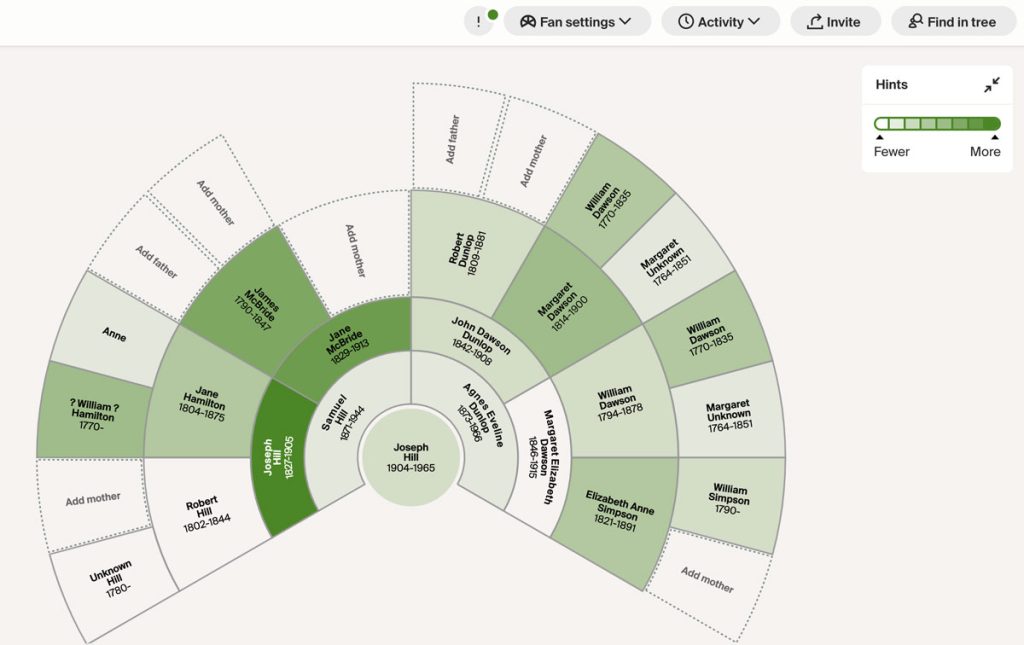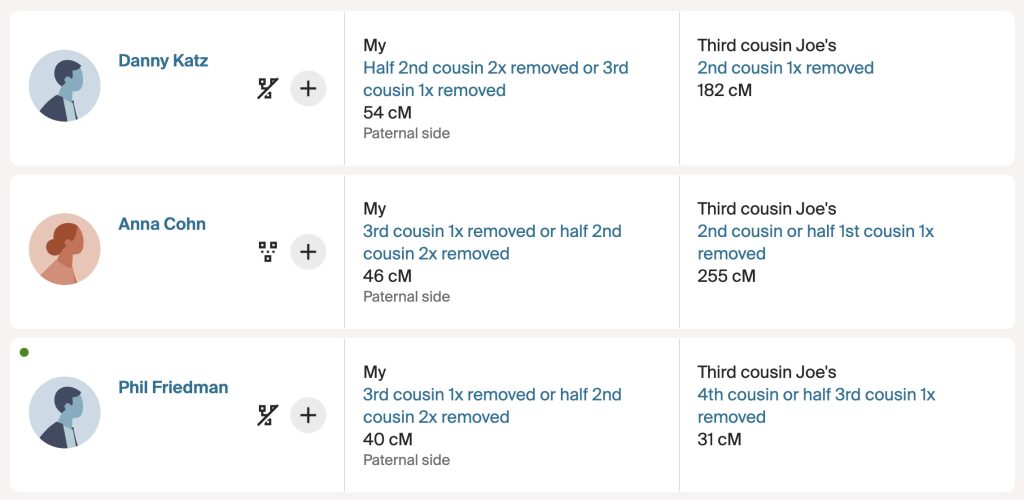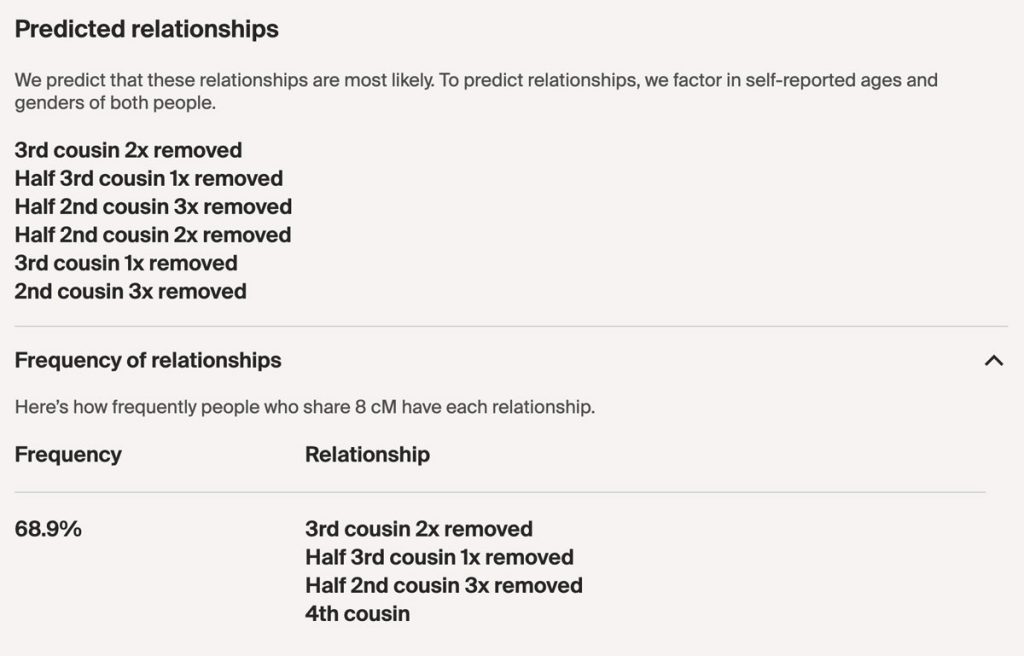In case you didn’t hear, you can now see how much DNA your matches share with each other within Ancestry Pro Tools. I’ve been very patient, and this feature finally arrived for me late on the evening of June 24th, 2024. Pro Tools is not available everywhere, although Ancestry’s website isn’t clear on this. I am based in the UK and am now able to get it.
What is it?
All DNA testing sites currently allow you to see shared matches:
- When you view a match, they provide a list of the other people in that database who share DNA with both you and the match
- At AncestryDNA, matches only appear in this shared match list if they share 20cM or more of DNA with you
Until now, the only testing companies that also told you how much DNA your matches shared with each other were 23andMe and MyHeritage. Ancestry has now joined them, but there’s an additional cost involved.
How much is it?
In the UK, the cost is £4.99 per month. In the US it’s $10 and in New Zealand it’s NZ$15.
[UPDATE: either this was an introductory price or they are experimenting since I’ve now heard £7.00 is being charged in the UK]
This includes other features beyond the scope of this post, including tree-checking and mapping tools, and a nifty fan chart that seems very familiar to me (yes, it reminds me of the ancestral charts on my favourite website!)

Some will baulk at this extra cost, but the take-up from DNA enthusiasts will be significant. Also, since you can pay for just one month, those short of funds won’t need to miss out.
My experience
Suddenly being able to access this additional information for matches I’ve been scrutinizing for years has been fascinating.
At first glance, this doesn’t feel like it should be anything special. After all, you can already do this at 23andMe and MyHeritage as well as the third-party upload site Gedmatch.
But at Ancestry:
- The huge size of the database increases its usefulness
- So even though many users still provide close to zero family info, it’s far more likely that you’ll find a useful tree among the shared matches, particularly since they now include matches in the 7 to 19cM range
- Lots of information was previously withheld, which adds to the impact of having it now:
- I got to know my matches and shared matches without any inkling of how they might have been related to each other
Useful smaller matches
This ability to see smaller shared matches is perhaps the biggest surprise impact for me. Previously, Ancestry made the decision not to show these. I suspect their reasons for this were quite noble:
- You can’t assume that all shared matches are related to the match the same way you are
- The smaller a match, the more likely it is that it could have come from a distant undocumented line
However, as a European working with a reasonably low number of matches overall:
- There are a lot of useful shared matches I’ve never seen before, particularly around the 15-19cM level!
A new possible workflow
This has enabled me to connect matches, many with good trees, in a way that wasn’t feasible before. My process has been:
- I click on a match where I know which line they’re on, even if I don’t know the precise connection
- There will be several shared matches I’ve never seen before because they share only 7 to 20cM with me. But they share more, sometimes a lot more, with the match
- This tells me they might be related closely enough for me to research
- One or more of these matches may have a good enough tree for me to be able to make the connection
At the moment the table can’t be sorted by amount on the match’s side, which is a great feature at MyHeritage.
Lower sharing matches with endogamous ancestry
In general, investigating matches via my Jewish grandfather at Ancestry has been a non-starter. I have three known matches, followed by a vast group of unknowns sharing multiple tiny segments. This vast group consists mostly of people to whom I’m connected multiple times long before the genealogical timeframe.
But it’s likely that there are some traceable 3rd/4th/5th cousins hiding in this group. I can now potentially spot these people more easily:
- I can view shared matches for a known Jewish match
- I generally see many people sharing up to about 70cM with me
- When I scan the right-hand column, I may see some matches who share far more DNA (say 150 to 400cM) with the match
- These are people with whom I probably share a more recent connection despite sharing only a small amount of DNA

The same scenario applies to non-endogamous matches of course. But the effect is even more striking here.
More data for analysis
One great potential benefit of this extra data is the possibilities it holds for tools like What are the Odds? and BanyanDNA:
- It will now be far easier to investigate mystery matches at Ancestry
- You will now have access to lots of additional data that you can use to validate your tree
This data is useful even without extra tools. For example, I can now see I was on the right track in identifying a 3C1R sharing 40cM. I can now see she shares appropriately larger amounts of DNA with other matches on that line.
One gripe
There’s only one thing that seems problematic for me:
- Predicted relationships for distant matches seem very optimistic
This has long been an issue at all testing sites. But it seems more extreme here. For example, this is misleading:

Unusually for a 20cM match, I was actually able to identify this person. They were a 5C1R. The vast majority of my 20cM matches are more distant than this, which is why I find the suggestions unhelpful.
For an 8cM match, the following was suggested:

To be fair, if you click on these over-specific estimates, you do see additional possibilities. But they never acknowledge that the vast majority of tiny matches are distant!

I don’t really understand why. This doesn’t even include 5th cousin as a possibility! And since many won’t click, the concise view also needs to indicate that small matches can be very distant. I hope Ancestry can improve this.
In summary
Overall, I’m overwhelmed with new research possibilities. This is a good thing. I’m confident that in the long term this new functionality will make my DNA research far more targeted.
I’m amused that the perhaps the two most useful aspects of this feature are the increased ability to work with two things that are often controversial and derided:
- Small 7-19cM matches
- Online family trees
However, context is everything:
- These matches have additional credibility based on the other data that we can now see, plus
- The sheer number of user trees means that you have a better chance of finding good research.
Finally
OK I can’t help myself:
- I now have the potential to identify more and more matches
- Inevitably, I can’t help thinking how great it would be to have segment data for these matches as well
This would make that monthly subscription extremely attractive…
I hope you’re enjoying exploring all this new data and that you make some amazing breakthroughs!
Contact info: @dnapainter.bsky.social / jonny@dnapainter.com
